Enhanced U-Net++ for Improved Semantic Segmentation in Landslide Detection
Abstract
1. Introduction
1.1. Global Impact of Landslides
1.2. Methods for Landslide Investigation
1.3. Specific Challenges Faced by Current Research Methods
- Selective Kernel (SK) attention module: This dynamically recalibrates multi-scale feature weights, resolving ambiguities in complex terrains while preserving fine-grained landslide boundaries.
- Dual-boundary sliding window strategy: This optimizes data augmentation by retaining critical topographic context and mitigating class imbalance, addressing the challenges of limited training samples.
- Cross-modal validation: This demonstrates unprecedented generalization capabilities across satellite (Wenchuan) and UAV (Moxi Town) datasets, establishing a versatile tool for real-world landslide monitoring.
- Section 2 details the CAS Landslide Dataset and preprocessing pipeline, emphasizing the role of our sliding window strategy in enhancing data utility.
- Section 3 elucidates the ASK-UNet++ architecture, with a focus on the SK attention mechanism’s role in feature fusion and its integration with nested skip connections.
- Section 4 rigorously evaluates the model against state-of-the-art benchmarks, validates its generalizability through cross-dataset testing, and quantifies the impact of individual components via ablation studies.
- Section 5 synthesizes the experimental findings, discusses practical implications for disaster risk management, and explores limitations and challenges in real-world deployment.
- Section 6 concludes by summarizing the model’s breakthroughs in accuracy and adaptability, proposes extensions to debris flow detection, and outlines future directions for lightweight real-time deployment and multi-modal data fusion.
2. Materials and Methods
2.1. Landslide Events in Research Area
2.2. Dataset and Data Processing
2.3. Data Processing
3. Methodology
3.1. Overall Architecture
3.2. Model Design
3.2.1. ASK Module
- is the weight matrix of the fully connected layer;
- is the bias vector;
- represents batch normalization;
- is an activation function;
- r is a reduction ratio controlling the bottleneck dimension;
- L is a minimum threshold ensuring sufficient feature expressiveness.
- are the weight parameters of the fully connected layers for each channel;
- and represent the attention weights for different receptive fields at channel c.
3.2.2. Loss Function
- P is the set of predicted positive samples.
- G is the set of ground truth positive samples.
- represents the number of correctly predicted positive samples.
- denotes the total number of predicted positive samples.
- denotes the total number of actual positive samples.
4. Results
4.1. Evaluation Metrics
- C: Total number of classes;
- Pi: Set of pixels predicted as class i;
- Gi: Set of pixels belonging to class i in the ground truth.
4.2. Experimental Results
5. Discussion
6. Conclusions
Author Contributions
Funding
Institutional Review Board Statement
Informed Consent Statement
Data Availability Statement
Conflicts of Interest
References
- Highland, L.M.; Bobrowsky, P. The Landslide Handbook—A Guide to Understanding Landslides; Number 1325; US Geological Survey: Lakewood, CO, USA, 2008.
- Hungr, O.; Leroueil, S.; Picarelli, L. The Varnes classification of landslide types, an update. Landslides 2014, 11, 167–194. [Google Scholar] [CrossRef]
- Hou, T.S.; Xu, G.L.; Shen, Y.J.; Wu, Z.Z.; Zhang, N.N.; Wang, R. Formation mechanism and stability analysis of the Houba expansive soil landslide. Eng. Geol. 2013, 161, 34–43. [Google Scholar] [CrossRef]
- Ni, H.; Tang, C.; Zheng, W.; Xu, R.; Tian, K.; Xu, W. An overview of formation mechanism and disaster characteristics of post-seismic debris flows triggered by subsequent rainstorms in Wenchuan earthquake extremely stricken areas. Acta Geol. Sin.-Engl. Ed. 2014, 88, 1310–1328. [Google Scholar] [CrossRef]
- Batar, A.K.; Watanabe, T. Landslide susceptibility mapping and assessment using geospatial platforms and weights of evidence (WoE) method in the Indian Himalayan Region: Recent developments, gaps, and future directions. ISPRS Int. J. Geo-Inf. 2021, 10, 114. [Google Scholar] [CrossRef]
- Kahlon, S.; Chandel, V.B.; Brar, K.K. Landslides in Himalayan mountains: A study of Himachal Pradesh, India. Int. J. IT Eng. Appl. Sci. Res. 2014, 3, 28–34. [Google Scholar]
- Jibson, R.W.; Harp, E.L.; Michael, J.A. A method for producing digital probabilistic seismic landslide hazard maps. Eng. Geol. 2000, 58, 271–289. [Google Scholar] [CrossRef]
- Cruden, D.M.; Varnes, D.J. Landslide types and processes. In Landslides: Investigation and Mitigation; Special Report, 247; Transportation Research Board, US National Academy of Sciences: Washington, DC, USA, 1996; pp. 36–57. [Google Scholar]
- Pazzi, V.; Morelli, S.; Fanti, R. A review of the advantages and limitations of geophysical investigations in landslide studies. Int. J. Geophys. 2019, 2019, 2983087. [Google Scholar] [CrossRef]
- Jensen, J.R. Remote Sensing of the Environment: An Earth Resource Perspective 2/e; Pearson Education India: Chennai, India, 2009. [Google Scholar]
- Ghaderpour, E.; Antonielli, B.; Bozzano, F.; Mugnozza, G.S.; Mazzanti, P. A fast and robust method for detecting trend turning points in InSAR displacement time series. Comput. Geosci. 2024, 185, 105546. [Google Scholar] [CrossRef]
- Kalavrezou, I.E.; Castro-Melgar, I.; Nika, D.; Gatsios, T.; Lalechos, S.; Parcharidis, I. Application of time series INSAR (SBAS) method using sentinel-1 for monitoring ground deformation of the Aegina Island (Western Edge of Hellenic Volcanic Arc). Land 2024, 13, 485. [Google Scholar] [CrossRef]
- Cheng, Y.; Pang, H.; Li, Y.; Fan, L.; Wei, S.; Yuan, Z.; Fang, Y. Applications and Advancements of Spaceborne InSAR in Landslide Monitoring and Susceptibility Mapping: A Systematic Review. Remote Sens. 2025, 17, 999. [Google Scholar] [CrossRef]
- Chambers, J.; Wilkinson, P.; Kuras, O.; Ford, J.; Gunn, D.; Meldrum, P.; Pennington, C.; Weller, A.; Hobbs, P.; Ogilvy, R. Three-dimensional geophysical anatomy of an active landslide in Lias Group mudrocks, Cleveland Basin, UK. Geomorphology 2011, 125, 472–484. [Google Scholar] [CrossRef]
- Sujitapan, C.; Kendall, J.; Chambers, J.; Yordkayhun, S. Landslide assessment through integrated geoelectrical and seismic methods: A case study in Thungsong site, southern Thailand. Heliyon 2024, 10, e24660. [Google Scholar] [CrossRef] [PubMed]
- Superczyńska, M.; Maślakowski, M.; Mieszkowski, R. Three-dimensional interpretation of geophysical and geotechnical investigation of landslides. Arch. Civ. Eng. 2024, 70, 99–111. [Google Scholar] [CrossRef]
- Darvishi, M.; Schlögel, R.; Kofler, C.; Cuozzo, G.; Rutzinger, M.; Zieher, T.; Toschi, I.; Remondino, F.; Mejia-Aguilar, A.; Thiebes, B.; et al. Sentinel-1 and ground-based sensors for continuous monitoring of the Corvara Landslide (South Tyrol, Italy). Remote Sens. 2018, 10, 1781. [Google Scholar] [CrossRef]
- Jiang, Y.; Liao, M.; Zhou, Z.; Shi, X.; Zhang, L.; Balz, T. Landslide deformation analysis by coupling deformation time series from SAR data with hydrological factors through data assimilation. Remote Sens. 2016, 8, 179. [Google Scholar] [CrossRef]
- Zhang, Q.; Wang, T. Deep learning for exploring landslides with remote sensing and geo-environmental data: Frameworks, progress, challenges, and opportunities. Remote Sens. 2024, 16, 1344. [Google Scholar] [CrossRef]
- Fan, X.; Scaringi, G.; Domènech, G.; Yang, F.; Guo, X.; Dai, L.; He, C.; Xu, Q.; Huang, R. Two multi-temporal datasets that track the enhanced landsliding after the 2008 Wenchuan earthquake. Earth Syst. Sci. Data 2019, 11, 35–55. [Google Scholar] [CrossRef]
- Xu, Y.; Ouyang, C.; Xu, Q.; Wang, D.; Zhao, B.; Luo, Y. CAS Landslide Dataset: A Large-Scale and Multisensor Dataset for Deep Learning-Based Landslide Detection. Sci. Data 2024, 11, 12. [Google Scholar] [CrossRef]
- Ronneberger, O.; Fischer, P.; Brox, T. U-net: Convolutional networks for biomedical image segmentation. In Proceedings of the Medical Image Computing and Computer-Assisted Intervention–MICCAI 2015: 18th International Conference, Munich, Germany, 5–9 October 2015; Proceedings, Part III 18. Springer: Berlin/Heidelberg, Germany, 2015; pp. 234–241. [Google Scholar]
- Yuan, Q.; Shen, H.; Li, T.; Li, Z.; Li, S.; Jiang, Y.; Xu, H.; Tan, W.; Yang, Q.; Wang, J.; et al. Deep learning in environmental remote sensing: Achievements and challenges. Remote Sens. Environ. 2020, 241, 111716. [Google Scholar] [CrossRef]
- Simonyan, K.; Zisserman, A. Very Deep Convolutional Networks for Large-Scale Image Recognition. In Proceedings of the International Conference on Learning Representations, San Diego, CA, USA, 7–9 May 2015. [Google Scholar]
- Li, X.; Wang, W.; Hu, X.; Yang, J. Selective kernel networks. In Proceedings of the IEEE/CVF Conference on Computer Vision and Pattern Recognition, Long Beach, CA, USA, 15–20 June 2019; pp. 510–519. [Google Scholar]
- Zhou, Z.; Rahman Siddiquee, M.M.; Tajbakhsh, N.; Liang, J. Unet++: A nested u-net architecture for medical image segmentation. In Proceedings of the Deep Learning in Medical Image Analysis and Multimodal Learning for Clinical Decision Support: 4th International Workshop, DLMIA 2018, and 8th International Workshop, ML-CDS 2018, Granada, Spain, 20 September 2018; Proceedings 4. Springer: Berlin/Heidelberg, Germany, 2018; pp. 3–11. [Google Scholar]
- Jadon, S. A survey of loss functions for semantic segmentation. In Proceedings of the 2020 IEEE Conference on Computational Intelligence in Bioinformatics and Computational Biology (CIBCB), Via del Mar, Chile, 27–29 October 2020; IEEE: Piscataway, NJ, USA, 2020; pp. 1–7. [Google Scholar]
- Everingham, M.; Van Gool, L.; Williams, C.K.; Winn, J.; Zisserman, A. The pascal visual object classes (voc) challenge. Int. J. Comput. Vis. 2010, 88, 303–338. [Google Scholar] [CrossRef]
- Le, C.; Pham, L.; Lampert, J.; Schlögl, M.; Schindler, A. Landslide Detection and Segmentation Using Remote Sensing Images and Deep Neural Networks. In Proceedings of the IGARSS 2024–2024 IEEE International Geoscience and Remote Sensing Symposium, Athens, Greece, 7–12 July 2024; IEEE: Piscataway, NJ, USA, 2024; pp. 9582–9586. [Google Scholar]
- Soares, L.P.; Dias, H.C.; Garcia, G.P.B.; Grohmann, C.H. Landslide segmentation with deep learning: Evaluating model generalization in rainfall-induced landslides in Brazil. Remote Sens. 2022, 14, 2237. [Google Scholar] [CrossRef]
- Ghorbanzadeh, O.; Xu, Y.; Ghamisi, P.; Kopp, M.; Kreil, D. Landslide4sense: Reference benchmark data and deep learning models for landslide detection. arXiv 2022, arXiv:2206.00515. [Google Scholar] [CrossRef]
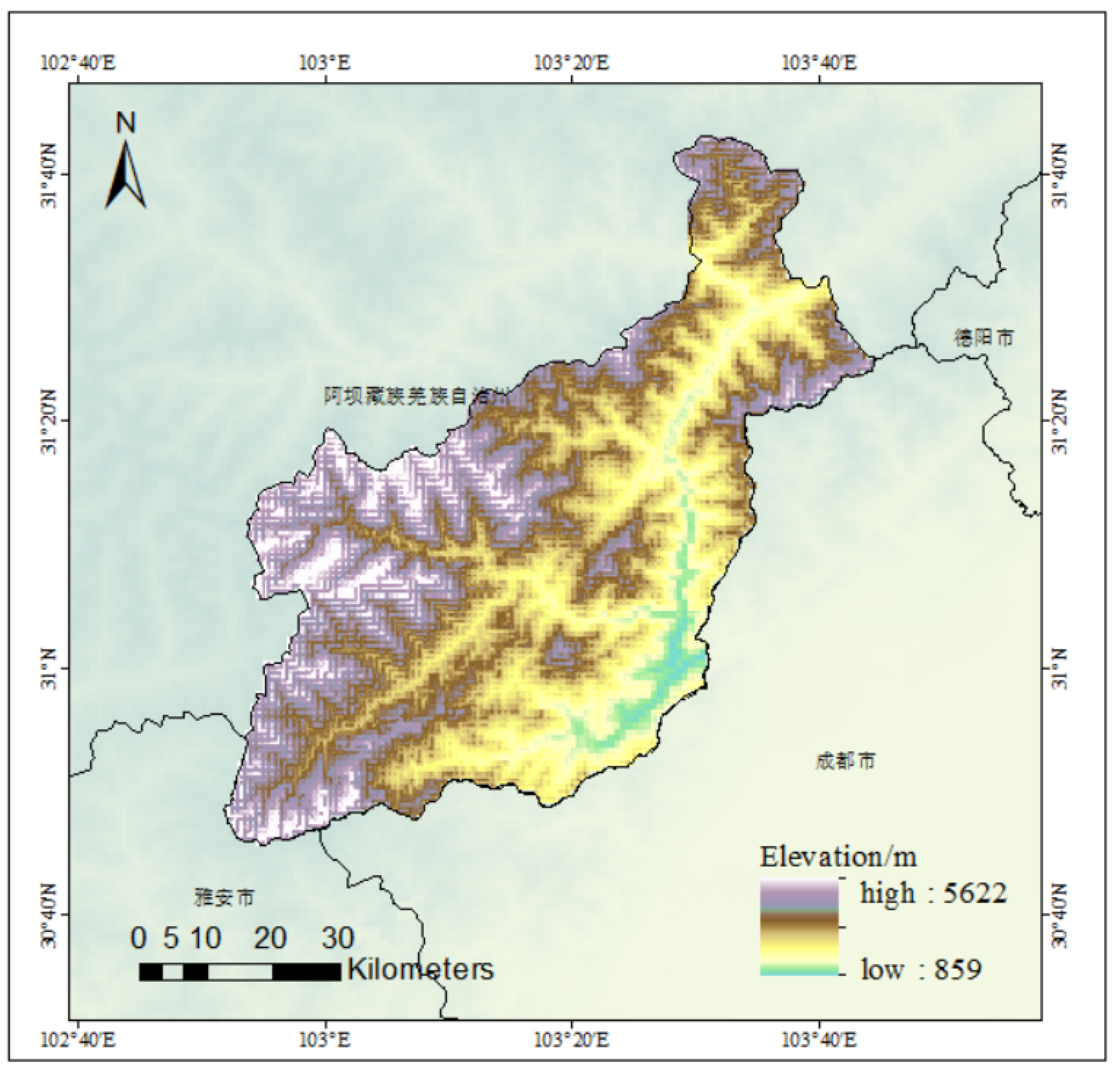
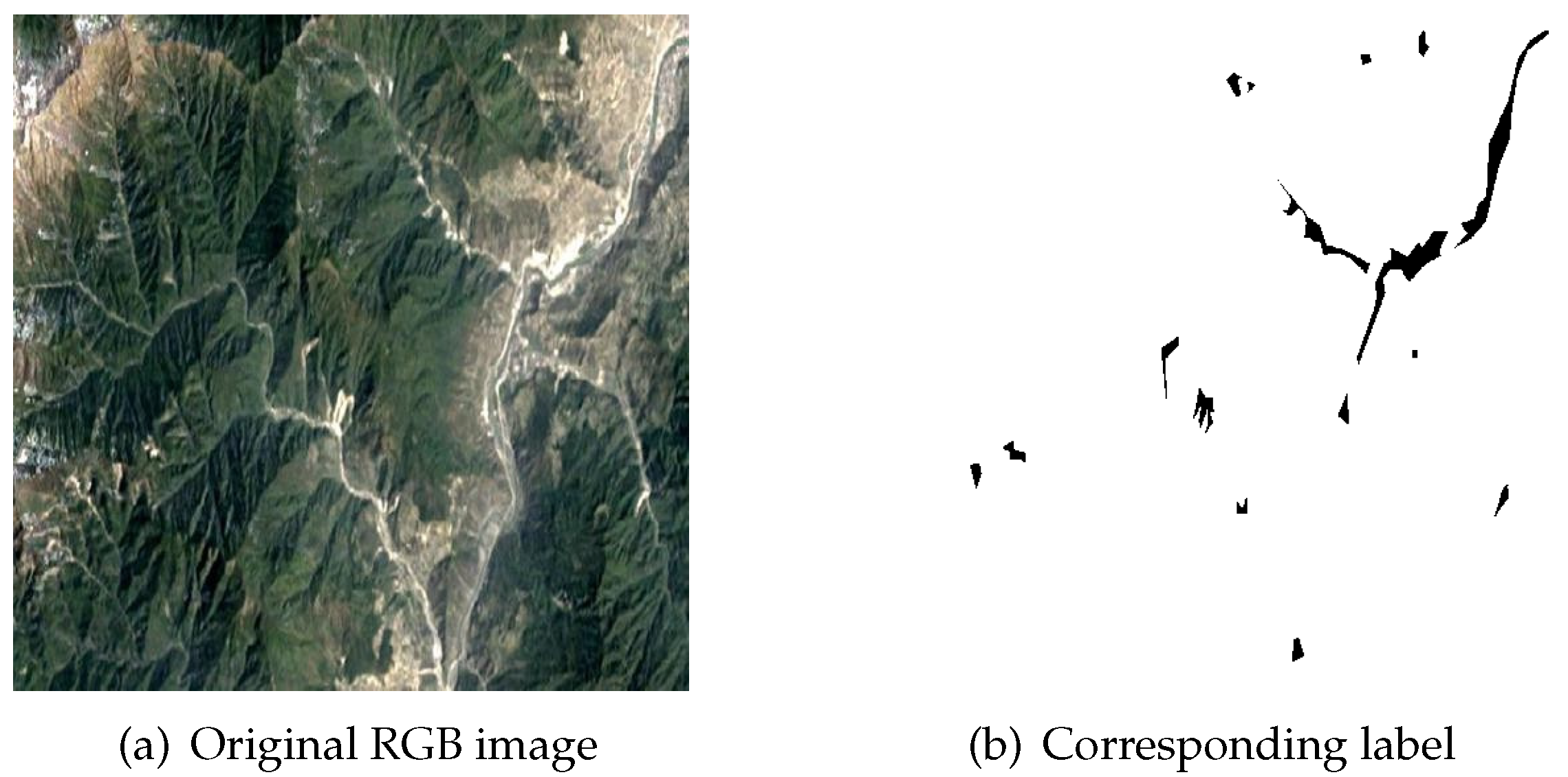
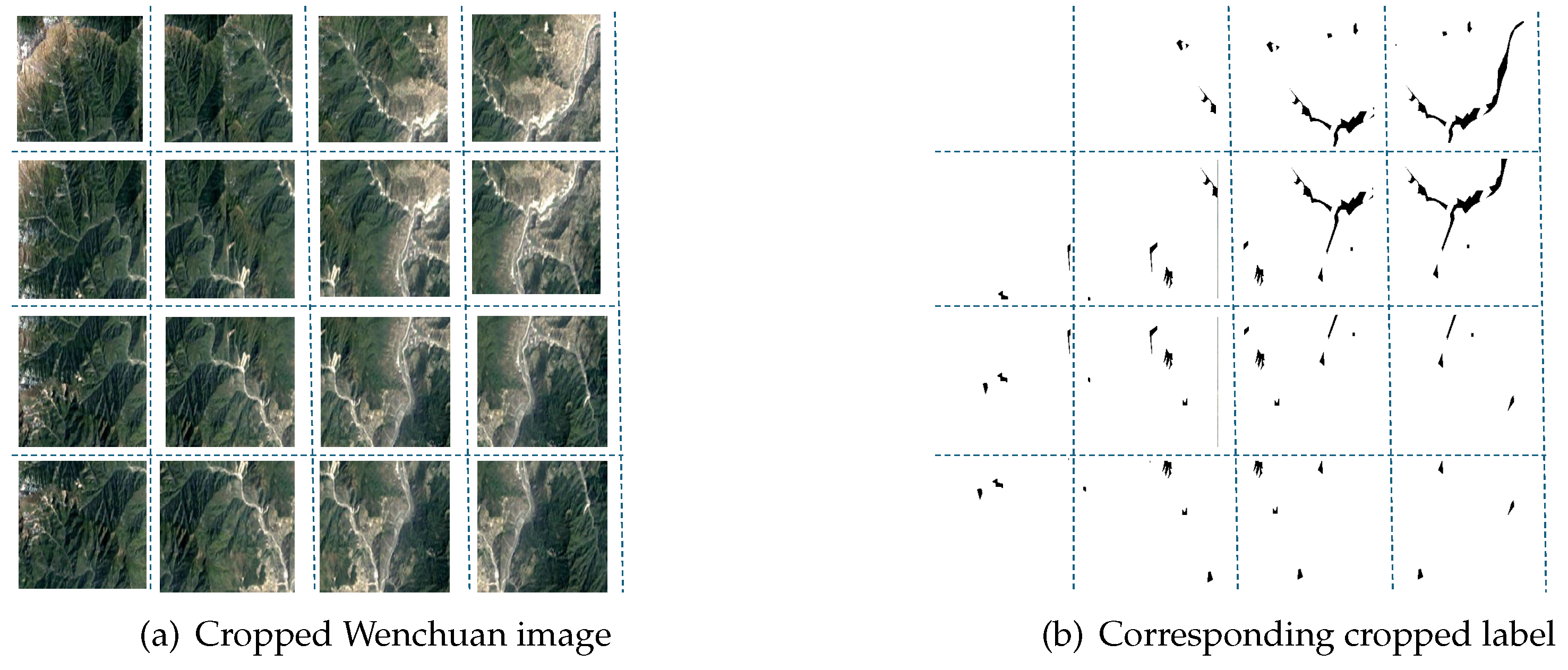
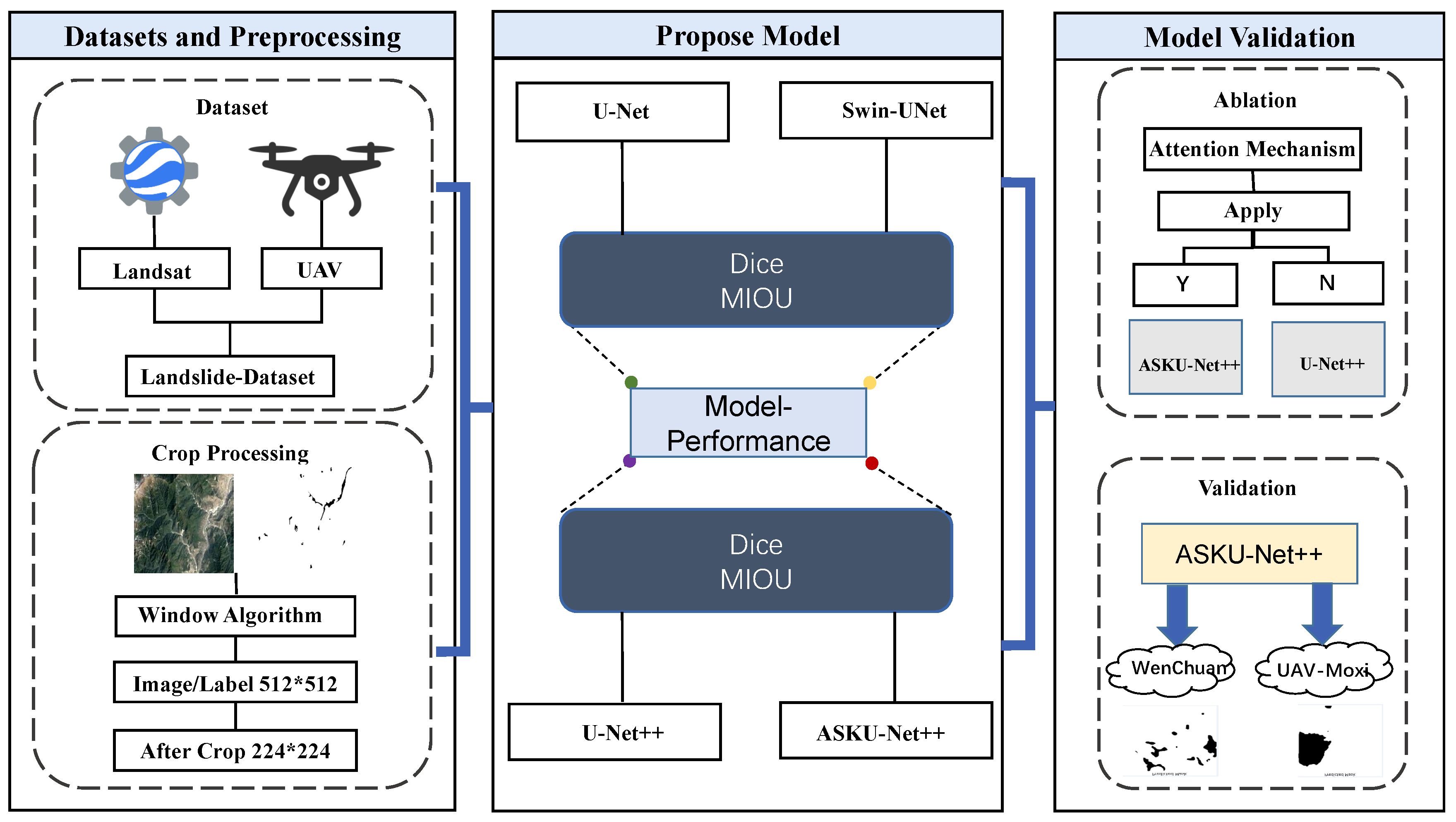



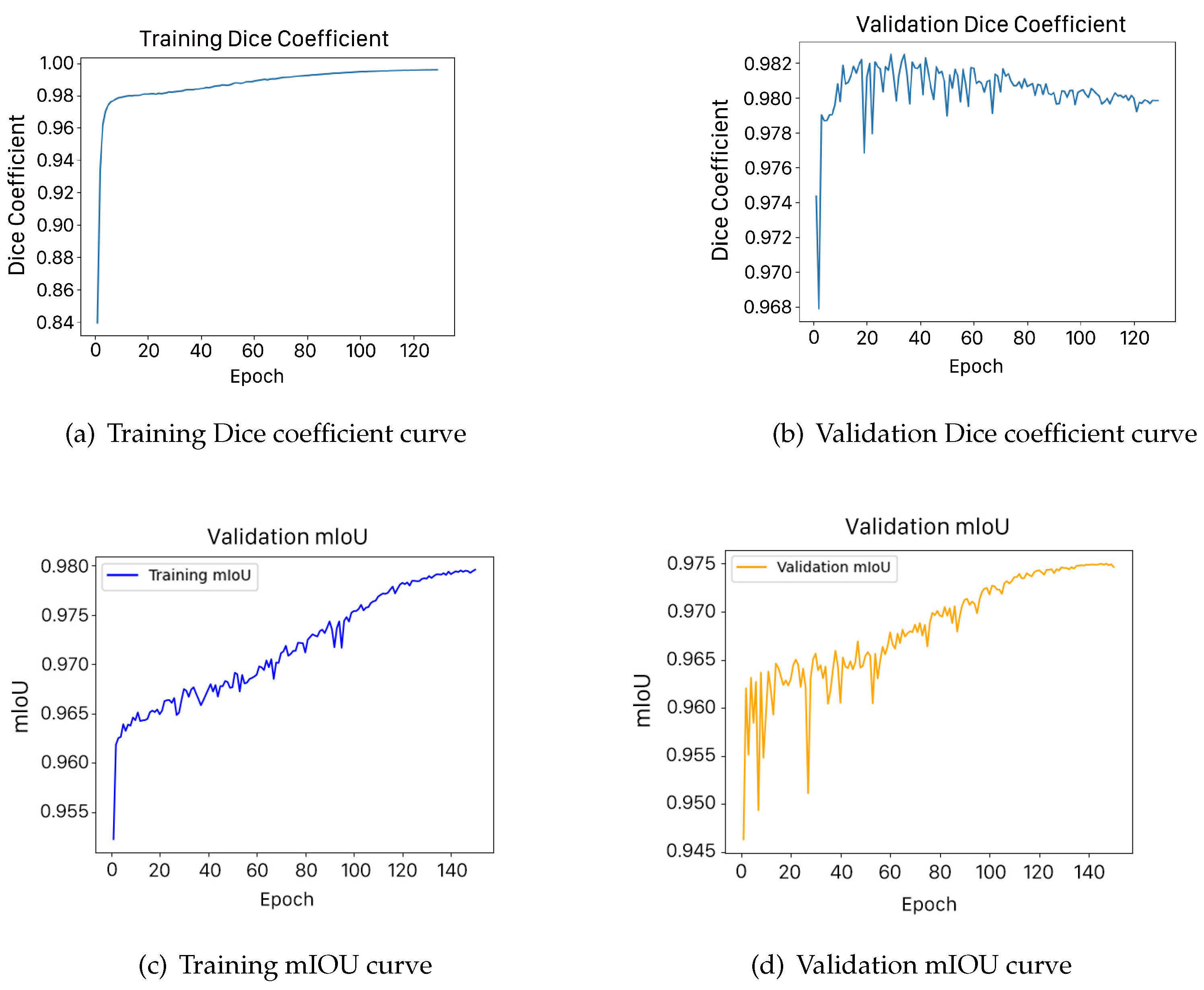


| Research Method | Advantages | Limitations |
|---|---|---|
| Ground Investigation [14,15] |
|
|
|
| |
|
| |
|
| |
|
| |
| Geological Exploration [16] |
|
|
|
| |
|
| |
| Remote Sensing Techniques [17] |
|
|
|
| |
| Radar Data [18] |
|
|
|
| |
|
| |
|
| |
|
| |
|
| Dataset | Date | Resolution | Original Image Amount | After Crop Image Amount | Original Label Amount | After Crop Label Amount |
|---|---|---|---|---|---|---|
| Wenchuan | Nov–Dec 2008 | 5 m | 178 | 2848 | 178 | 2848 |
| Moxi Town | Sep–Oct 2022 | 0.2 m | 1635 | 26,160 | 1635 | 26,160 |
| Parameter | Value |
|---|---|
| Initial learning rate | |
| Batch size | 16 |
| Number of epochs | 120–150 |
| Optimizer | Adam |
| Learning rate scheduler | Cosine Annealing |
| Early stopping patience | 150 |
| Validation | 20% |
| Test set | 20% |
| Training set | 60% |
| Regularization | L2 Regularization (weight decay), Dropout (0.5) |
| Hardware environment | NVIDIA RTX A6000 (NVIDIA, Santa Clara, CA, USA) |
| Model | mIoU (%) | Dice (%) | F1 (%) | Precision (%) | Recall (%) | Accuracy (%) |
|---|---|---|---|---|---|---|
| U-Net | 92.73 | 91.43 | 93.28 | 90.12 | 91.56 | 92.45 |
| Swin-UNet | 91.27 | 92.36 | 90.89 | 92.15 | 91.78 | 93.51 |
| U-Net++ | 94.25 | 93.81 | 93.17 | 94.59 | 92.88 | 95.23 |
| ASK-UNet++ | 97.53 | 98.27 | 97.53 | 98.40 | 96.76 | 96.04 |
Disclaimer/Publisher’s Note: The statements, opinions and data contained in all publications are solely those of the individual author(s) and contributor(s) and not of MDPI and/or the editor(s). MDPI and/or the editor(s) disclaim responsibility for any injury to people or property resulting from any ideas, methods, instructions or products referred to in the content. |
© 2025 by the authors. Licensee MDPI, Basel, Switzerland. This article is an open access article distributed under the terms and conditions of the Creative Commons Attribution (CC BY) license (https://creativecommons.org/licenses/by/4.0/).
Share and Cite
Tang, M.; He, Y.; Aslam, M.; Akpokodje, E.; Jilani, S.F. Enhanced U-Net++ for Improved Semantic Segmentation in Landslide Detection. Sensors 2025, 25, 2670. https://doi.org/10.3390/s25092670
Tang M, He Y, Aslam M, Akpokodje E, Jilani SF. Enhanced U-Net++ for Improved Semantic Segmentation in Landslide Detection. Sensors. 2025; 25(9):2670. https://doi.org/10.3390/s25092670
Chicago/Turabian StyleTang, Meng, Yuelin He, Muhammed Aslam, Edore Akpokodje, and Syeda Fizzah Jilani. 2025. "Enhanced U-Net++ for Improved Semantic Segmentation in Landslide Detection" Sensors 25, no. 9: 2670. https://doi.org/10.3390/s25092670
APA StyleTang, M., He, Y., Aslam, M., Akpokodje, E., & Jilani, S. F. (2025). Enhanced U-Net++ for Improved Semantic Segmentation in Landslide Detection. Sensors, 25(9), 2670. https://doi.org/10.3390/s25092670






